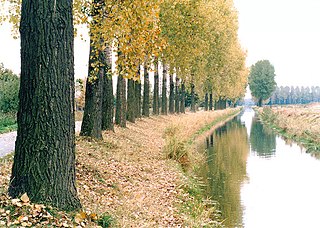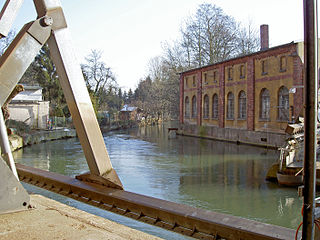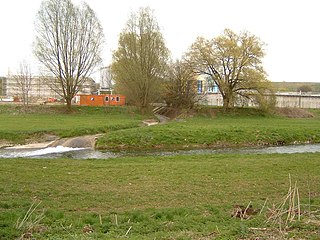
The Aller is a 215-kilometre-long (134 mi) river in the states of Saxony-Anhalt and Lower Saxony in Germany. It is a right-hand, and hence eastern, tributary of the Weser and is also its largest tributary. Its last 117 kilometres (73 mi) form the Lower Aller federal waterway. The Aller was extensively straightened, widened and, in places, dyked during the 1960s to provide flood control of the river. In a 20-kilometre-long (12 mi) section near Gifhorn, the river meanders in its natural river bed.

The Leine is a river in Thuringia and Lower Saxony, Germany. It is a left tributary of the Aller and the Weser and is 281 km (175 mi) long.

Gleichen is a municipality in the district of Göttingen, in Lower Saxony, Germany. Named after the two castles, Neuen-Gleichen and Alten-Gleichen on the twin peaks in the Gemeinde, it is situated about 10 km southeast of Göttingen, from which the peaks are visible. Its seat is Reinhausen.

The Innerste is a river in Lower Saxony, Germany. It is a right tributary of the Leine river and 101 km (63 mi) in length.
Diemarden is a village in Gleichen in the Göttingen district of Lower Saxony, Germany. It had 1463 inhabitants as of 2005 and is the second largest village in Gleichen. In 2010, there were 1398 residents. The village's elevation is 172 meters above mean sea level. The village lies along the Garte stream, a tributary to the Leine river.

Lutter is a river in Göttingen, Lower Saxony, Germany. It is a tributary from the right (east) to the Leine.
The Garte Valley Railway or Göttingen Narrow Gauge Railway, was a narrow-gauge rail line that served to connect the area east of the city to Göttingen, Lower Saxony, Germany, from 1897 through 1959.

The Hildesheim Forest is a range of hills up to 359 m above sea level (NN) in the district of Hildesheim in the German state of Lower Saxony.

Die Gleichen are a pair of hills, up to 430 metres high, in the district of Göttingen in South Lower Saxony in Germany. The twin hills, that were once the site of two fortifications, gave their name to the village of Gleichen.

The Solling-Vogler Nature Park is a nature park in South Lower Saxony in Germany. It has an area of 52,000 hectares (200 sq mi) and was established in 1966.

The Große Aue is an 88-kilometre-long (55 mi), southwestern, left tributary of the River Weser in northern North Rhine-Westphalia and central Lower Saxony in Germany.

The Leine-Heide Cycle Path is a long-distance cycle path in Germany that has a total length of 410 kilometres (250 mi) and runs through the German federal states of Thuringia, Lower Saxony and Hamburg. Until 2009, it was called the Leine Cycle Path, after the River Leine; it ended north of the river's confluence with the Aller in Hodenhagen. Heide (‘heath’) refers to the Lüneburg Heath.

The Sebnitz is the left, larger headstream of the Lachsbach and runs through both the Czech Republic as well as the German state of Saxony. The upper section in the Czech Republic is known as Vilémovský potok in Czech and Wölmsdorfer Bach in German.

The Solling Railway (German: Sollingbahn is a non-electrified, single track standard gauge railway connecting Höxter-Ottbergen in the east of the German state of North Rhine-Westphalia and Northeim in southern Lower Saxony. It takes its name from the fact that it runs through the southern Solling in Lower Saxony, an area of large forests and low mountains.

The Göttingen Forest is a ridge in Germany's Central Uplands that is up to 427.5 metres high. It forms part of the Lower Saxon Hills in South Lower Saxony.

The Sackwald is a ridge, up to 374 m above sea level (NN) high, in the Lower Saxon Hills in the district of Hildesheim in the North German state of Lower Saxony. It is named after the village of Sack in the borough of Alfeld, the name meaning "Sack Forest".
The Rotenberg is a hill range, up to 317.3 m high, in the Lower Saxon Hills in southeastern Lower Saxony, Germany.
The Göttingen–Bodenfelde railway, also called the Oberweserbahn and in Göttingen the Bodenfelder Bahn, is a standard gauge railway in South Lower Saxony. The single-track, non-electrified branch line runs from Göttingen to Bodenfelde through the Weser Uplands. It is used mainly by local traffic, but it is also used by through traffic. The route was once used, for example, by Düsseldorf–Göttingen traffic.

The Helleberg is a hill ridge up to 297.5 m above NN in the Lower Saxon Hills and within the counties of Hildesheim and Northeim in Lower Saxony, Germany.















